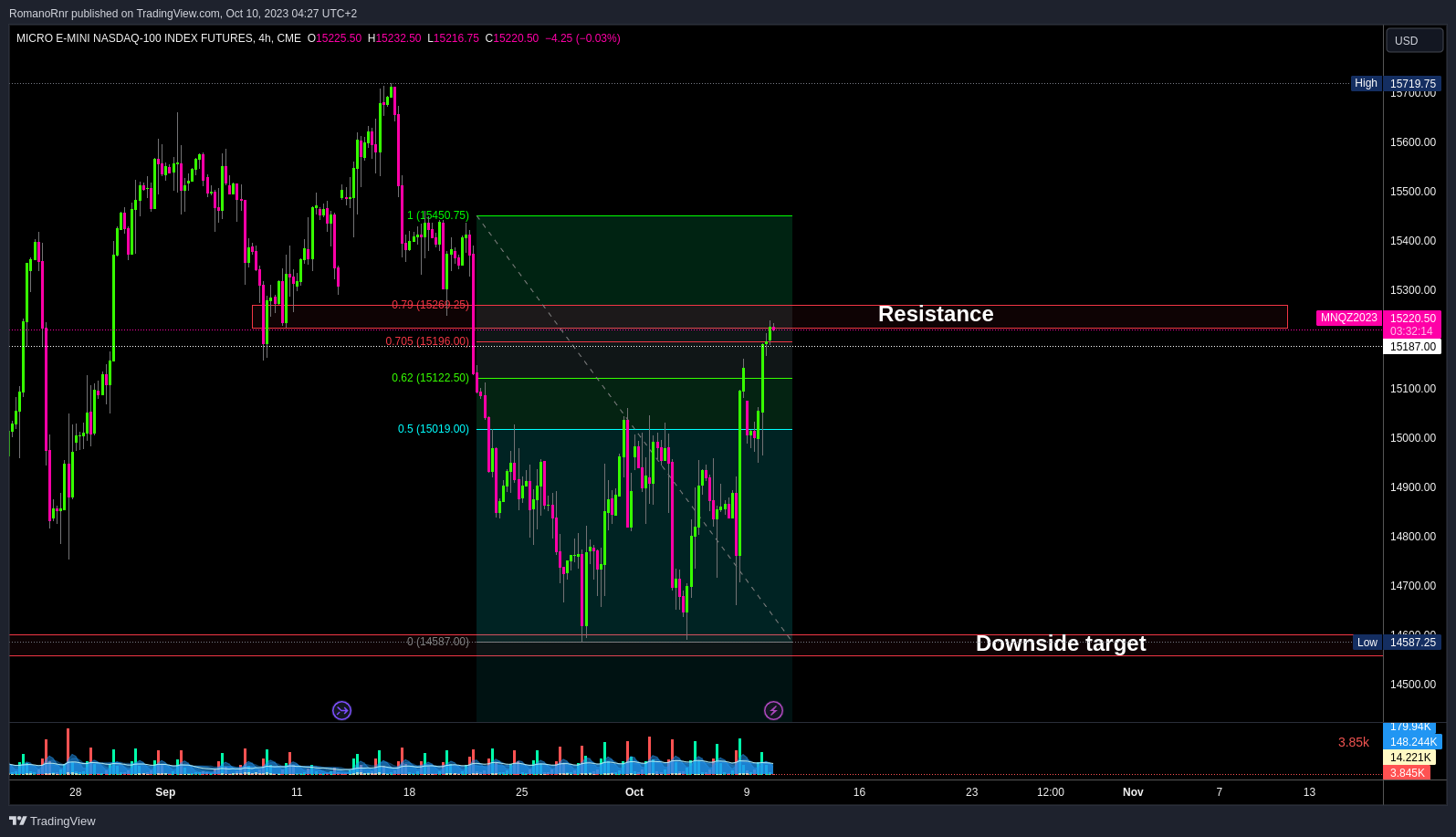From Hawk to Dove? Just like that?

Following the September job figures, which weren't as positive as expected, there was immediate apprehension in the markets about a potential rise in the Federal Reserve's
Then, last Friday, the Non-farm payroll came out, a 6 sigma beat above expectations. Initially, there was a panic reaction because the strong job market could give the Federal Reserve a reason to hike interest rates again. 10Y yield spiked to 4.85%.

However, following the initial shock, stock markets experienced a surge, primarily driven by a short squeeze, and the anticipation for a further rate hike by the Fed in November diminished.

I've been pretty bearish since September 14/15 and also made another article called "Tactical hedging"

Federal Reserve's future actions
A key argument regarding the Fed's future actions by a trader from Goldman Sachs.
According to him, the Financial Conditions Index (FCI) has been tightening due to the sell-off in long-term rates and a stronger US dollar, which could potentially cancel the further need for more rate hikes.
The Financial Conditions Index (FCI) takes into account several financial metrics, including long-term interest rates.
If these rates experience a significant sell-off, it greatly impacts the FCI. This is because 10-year U.S. Treasury (UST) yields make up a significant percentage (45.1%) of the index, whereas the Federal Funds rate only makes up a minor portion (4.4%).


10-year yields
Think of the 10-year U.S. Treasury bonds (10-year UST yields) as a big influencer in the world of money. So, if you wanted to get a mortgage for a house or a loan for your business, it might now cost you more because these rates have gone up. The FCI keeps an eye on this, and when these rates rise, it's like a signal that everyone might start to spend and invest a bit less.
When long-term rates drop, it shakes things up a lot for the FCI because the 10-year UST (basically a type of bond) holds a big chunk of the index's value, way more than the Federal Funds rate.
So, if these long-term rates keep going higher, it might mean the Fed doesn't have to hike rates again because the 10-year UST yield does a large job of tightening
a 25 basis point tightening in the Financial Conditions Index (FCI) can have a similar effect on the economy as a 25 basis point rate hike by the Federal Reserve, reducing economic growth by 25 basis points over the following year.
So, the 75 basis point tightening of the FCI since summer essentially acts like 3x a 25 bps rate hike by the Fed, and if this level of tightening remains. So, it's projected to lower the economic growth by about 75 basis points over the next year.

FCI cushion
Goldman points out that Mary Daly recently made some comments that hint she's being cautious because of shifts in the Financial Conditions Index (FCI).
This might be why people are hesitant to expect more rate hikes by the end of 2023, even though there's solid job growth data from the Non-Farm Payroll.

Basically, the FCI getting tighter has acted like a cushion. It's stopped the rates from going more "bear flattening" of the rates curve, thereby supporting steepeners even in light of strong economic data.
Bear flattening and steepeners?
When we talk about the "yield curve," we're looking at a graph that shows the interest rates on debt (like bonds) for a range of maturities. Usually, longer-term bonds have higher interest rates because there's more risk over time. But sometimes, the difference between short-term and long-term rates gets smaller.
When this happens in an environment where rates are rising (because people think the economy might heat up too much), and the short-term rates increase faster than the long-term rates, we call it "bear flattening." The "bear" part comes in because rising interest rates can be bad for bond prices.
A "steepener" is when the yield curve experiences an increase in its slope. This indicates that the difference between short-term and long-term interest rates is expanding. It can occur due to a faster decline in short-term rates than long-term rates or because long-term rates are increasing faster than short-term rates. When the yield curve is steepening, it is considered to be "supporting steepeners."
Lorie Logan, Dallas Fed President and former leader of the "NY Fed's Plunge Protection Team" echoed Daly's sentiments, mentioning.
The increase in long-term Treasury yields may reduce the need for the Federal Reserve to raise its benchmark interest rate.
Logan, in her prepared address for a National Association for Business Economics meeting, highlighted that when term premiums increase, term interest rates also rise, even without any changes in the fed funds rate. That may help in "cooling down" the economy, potentially reducing the need for further tightening of monetary policy.
According to Logan, the premium is a term used to describe the extra yield that investors ask for when they take on the risk of interest rates changing/rising over the life of a bond.
She recognizes that increased term premiums have largely influenced recent moves in the yield curve. However, she also points out that it is uncertain how much of an impact this will have in the long term.
Both Goldman Sachs and officials from the Federal Reserve, such as Daly and Logan, seem to be suggesting that the market dynamics, specifically the increasing yields on long-term Treasury bonds, which in turn is leading to the tightening of the Financial Conditions Index (FCI), are naturally causing a slowdown in the economy.
This moderation can reduce the need for the Federal Reserve to intervene with further rate hikes, as it balances growth and inflation.
Are you a premium newsletter member but still haven't joined Discord?
Join Discord to get the full value out of the newsletter. There's no extra cost associated with Discord. Yes, options data, such as dark pools, options gamma, unusual flow, etc., are also included. Also educational content, reports, and direct questions to me, and often I share my trades & thoughts in real-time as the market moves.
However, I want you to understand rather than just copy a trade.



$70 Trillion wiped out
So, Deutsche Bank has done some math and found out that bond prices have dropped so much that it's wiped out a $70 trillion in value from the global debt market. That's like the entire economy of many countries combined.
According to the Institute of International Finance (IIF), the global debt market is now more than $300 trillion.
Now, here's where it gets "funny". It's a big deal for the Federal Reserve. They're probably sweating bullets because this huge loss in value could mean bad news for the financial world.
It might be only a matter of time before some big financial mess-up happens because of this, and the Federal Reserve breaks something.
If things go south, central banks (like the Fed) might suddenly have to change their strategies.
They might have to cut interest rates quickly to try and fix the damage they've created by aggressively rate hiking too fast. This is ironic. This all wouldn't have happened if they acknowledged the inflation problem earlier.
So, they might be in this situation in the first place because they kept interest rates super low for a long time. So, it's like they went in a full circle, causing problems and then trying to fix them, only to end up right where they started. A never-ending cycle.
Nasdaq futures: this is a chart I got
I remain bearish and possibly terribly wrong in the short term. If it creeps above the resistance AND holds it, I may have to discard the idea of being bearish until ... whatever happens next.

ApeX DEX
ByBit has made KYC mandatory as many other exchanges. Why not try out ApeX DEX? You can use your wallet or social account to use the DeX. No gas fees are required for trading & the fast trading experience is like a CEX.
Consider ApeX DEX
Instructions:
https://twitter.com/RNR_0/status/1652360705331347461
For a lifetime fee discount, check the link
Signup: https://pro.apex.exchange/trade/BTC-USDC/register?affiliate_id=46&group_id=83
Ref code: 46
Also, you can use your socials like Gmail/Google, Discord etc to login on ApeX Dex if you're too lazy to many a wallet such as Metamask or blockwallet